Cost-Effectiveness Analysis of Wind Power Solutions


Intro
Wind power has emerged as one of the front-runners in the renewable energy race, but the question that hangs in the air is, is it cost-effective? As nations strive to transition from fossil fuels to cleaner energy sources, the hustle and bustle of this industry is hard to ignore. Understanding the cost-effectiveness of wind energy is not just a technical evaluation; it encapsulates economic forecasting, environmental impact assessment, and technological innovation. This article takes a deep dive into the intricate layers that define the financial viability of wind power, especially regarding the ever-evolving landscape of energy production.
Overview of Research Topic
Brief Background and Context
Historically, wind energy wasn’t seen as a serious competitor in the energy sphere. Early on, the costs associated with installing and maintaining wind turbines seemed daunting. However, substantial strides in technology, coupled with an increasing global push for sustainability, have reshaped this narrative. According to numerous studies, wind power’s share in global electricity generation has experienced exponential growth, reflecting a broader societal shift towards renewable energy. Countries like Denmark and Germany are often lauded for their successful integration of wind farms, serving as case studies for others harnessing this potential.
Importance in Current Scientific Landscape
In the wake of climate change, the world increasingly recognizes the pressing need for cleaner energy sources. The benefits of wind energy extend beyond reduced greenhouse gas emissions. The potential for job creation, energy independence, and technological advancements are tremendously significant. Furthermore, as solar and hydroelectric power gain traction, the solid interplay between these sources and wind energy illustrates a collaborative future in which diverse renewable technologies can thrive. Understanding the cost-effectiveness of wind energy isn’t just useful for academics or industry professionals; it affects everyday people investing in a sustainable future.
Methodology
Research Design and Approach
The analysis presented herein employs a comparative approach, assessing wind power against other energy sources like natural gas and coal. This method focuses on both qualitative and quantitative elements, drawing conclusions based on a range of metrics from installation costs to output efficiency.
Data Collection Techniques
To give a rounded picture of this rapidly changing field, the data collection process includes reviewing existing literature, interviewing industry experts, and analyzing recently published reports. Sources like Wikipedia and Britannica provide foundational statistics and historical context.
Additionally, platforms like Reddit can offer real-time discussions and insights from enthusiasts and experts alike, making them valuable for understanding current sentiments regarding wind energy.
"Cost-effectiveness isn't just numbers on a spread sheet; it's about securing a sustainable future for generations to come."
This section serves as a springboard into the deeper analyses that will follow, detailing both the challenges and advantages that wind power presents.
Preface to Wind Power
Wind power represents a pivotal piece in the puzzle of renewable energy solutions. As society faces the growing specter of climate change and associated environmental challenges, the significance of exploring sustainable sources becomes increasingly critical. Wind energy stands out due to its abundance and availability in many parts of the world. Transitioning toward this form of energy not only helps reduce our carbon footprint but also offers economic advantages that are hard to overlook.
Understanding wind power involves delving into its historical roots, current developments, and future potential. This article outlines these aspects thoroughly, considering factors like initial investments, ongoing costs, and technological advancements that play essential roles in shaping its feasibility as a reliable energy source.
Historical Overview of Wind Energy
The journey of wind energy can be traced back thousands of years to ancient civilizations. Windmills were first recorded in Persia around 500-900 AD, where they were utilized for milling grain and pumping water. Fast forward to the 19th century, wind power evolved significantly in Europe, particularly with the introduction of the American windmill that became widespread on farms, contributing to agricultural productivity.
However, modern wind energy began to take shape in the late 20th century with the oil crises of the 1970s, prompting a search for alternative energy sources. The first utility-scale wind farm opened in California in 1981. During the 1990s and early 2000s, technological advancements led to increased efficiency, providing a significant push toward broader adoption. Today, countries like Denmark and Germany lead the world in wind power generation, showcasing a successful transition from historical uses to contemporary contributions to national grids.
Current Landscape of Wind Power
Today, wind power is a rapidly growing sector globally, contributing significantly to renewable energy portfolios. The International Renewable Energy Agency reported that in 2021 alone, wind energy capacity reached over 840 gigawatts worldwide. As countries strive for energy independence and sustainability, wind has proven to be a viable alternative.
Wind farms are no longer just a collection of towering structures; they represent complex systems of advanced technology designed for optimal performance. Innovations in turbine design have resulted in larger, more efficient blades and improved energy conversion rates. Alongside this, offshore wind farms are becoming increasingly popular, offering access to stronger and more consistent winds.
The economic viability of wind power is further enhanced by government policies encouraging green energy. Various financing models and incentive programs, including tax credits and rebates, help offset the financial risks associated with investing in wind energy projects. Combined with an increasing public awareness of climate issues, the current landscape of wind power presents a ripe opportunity for growth and adaptation in the energy market.
Cost Components of Wind Power
Understanding the cost components of wind power is critical for evaluating its overall effectiveness as a renewable energy source. These costs not only shape the feasibility of wind energy projects but also play a vital role in determining their attractiveness compared to other forms of energy generation. By dissecting the financial elements involved in wind power, one can appreciate the economic dynamics at play, which significantly influence investment decisions and policy-making in the renewable sector.
Initial Capital Investment
The initial capital investment for wind power is often seen as a daunting figure. This expense typically includes the cost of purchasing and installing wind turbines, as well as any necessary infrastructure such as roads, electrical connections, and substations. The cost of turbines can vary widely depending on their size and technology. For instance, larger turbines with advanced technology may come with a hefty price tag, yet they often yield greater energy outputs, balancing the financial scales in their favor.
Moreover, selecting a site for wind farms is not merely a toss of a coin. Wind availability, land cost, and proximity to existing electrical grids are significant factors. Ideally, a site should offer strong and consistent winds to optimize energy generation. However, prime locations can command premium prices, sweetening the pot for initial investments.
The importance of thoroughly assessing these initial costs cannot be overstated. According to industry experts, projects that include detailed feasibility studies and comprehensive planning are more likely to stay within budget and achieve expected returns over time.
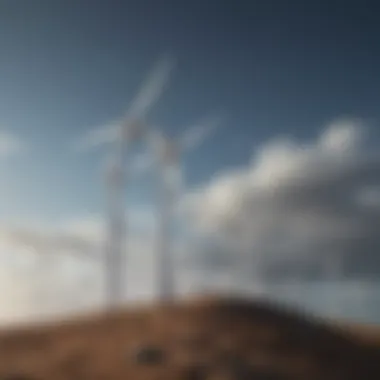
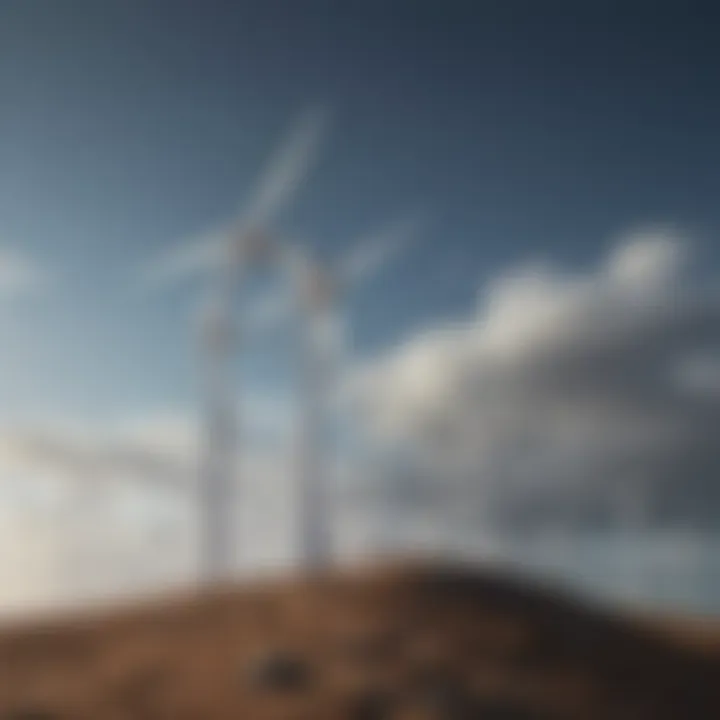
Operating and Maintenance Costs
Once a wind project is up and running, the focus shifts to operating and maintenance costs. These ongoing expenses, often overlooked in initial evaluations, are crucial for sustaining wind power's long-term viability. Generally, these costs encompass routine maintenance, repair services, and other operational necessities.
Regular maintenance ensures that turbines operate at peak efficiency. This may involve inspecting wind blades, lubricating moving parts, or replacing worn components. Interestingly, many modern wind turbines are equipped with predictive maintenance technology, which uses sensors and data analytics to foresee potential issues before they escalate into significant malfunctions. This proactive approach can help reduce downtime and repair costs.
Unforeseen weather events can also affect operational expenses. Extreme conditions may lead to additional wear or necessitate unscheduled repairs. Budgeting for such contingencies should be part of any wind power project’s financial planning.
Decommissioning Expenses
As a wind farm reaches the end of its operational life, understanding the decommissioning expenses is essential. This often-overlooked cost involves dismantling and removing turbines, restoring sites to their original state, and managing waste. Notably, regulations surrounding decommissioning vary across regions. Some areas require strict adherence to environmental guidelines, which can elevate costs considerably.
Preparing well in advance for decommissioning saves money in the long run. Establishing a financial reserve throughout the operational lifespan of the wind farm can mitigate the impact of these eventual costs when the time comes for closure. A well-planned decommissioning strategy can contribute to more sustainable practices, ensuring that the project leaves behind a minimal environmental footprint.
"Effective planning and management of wind power costs can pave the way for a greener and more sustainable energy future."
In summary, analyzing the cost components of wind power sheds light on its economic viability. From the hefty initial capital investments to ongoing operational costs and eventual decommissioning expenses, various financial elements play a crucial role in determining the success of wind energy as a sustainable alternative.
Technological Innovations in Wind Power
Technological innovations in wind power play a pivotal role in enhancing the efficiency and affordability of this renewable energy source. As we delve into this topic, it’s imperative to recognize that advancements are not merely about scaling up production but also about refining the approach to energy generation. Innovations in turbine design, energy storage systems, and smart grid integration have redefined what is possible in the wind energy sector, propelling it to the forefront of sustainable solutions.
Advancements in Turbine Design
Turbine design has witnessed significant strides, fundamentally altering how wind energy is captured. Modern turbines are engineered to extract more energy from the wind, even at lower speeds. This is crucial because wind speeds can sometimes be fickle, and having equipment capable of maximizing output under varied conditions can drastically improve the overall energy yield. For instance, the introduction of larger rotor diameters and taller towers allows turbines to harness wind from different altitudes, effectively increasing their productivity.
In addition, materials used in construction have evolved. Lighter, yet stronger materials not only reduce the cost of manufacturing but also improve durability, leading to lower maintenance expenses. Also worth mentioning are innovations like vertical-axis wind turbines, which present a different approach in design, providing efficiency in urban settings where traditional horizontal-axis turbines may not fit as well.
"The essence of innovation is to make the complex simple again. In wind power, this means turning natural resources into a practical energy supply without breaking the bank."
Energy Storage Solutions
Energy storage is a critical element in the effectiveness of wind power. Wind energy generation is inherently intermittent; the wind does not blow consistently. To combat this variability, suitable energy storage solutions must be implemented to ensure a steady energy supply when demand peaks. Technologies such as lithium-ion batteries, flow batteries, and even pumped hydro storage systems have become increasingly popular for storing excess energy generated during windy periods.
By using sophisticated energy management systems, utility companies and consumers can tap into stored wind energy as needed. Not only does this enhance reliability, but it also allows for peak shaving, which decreases the need for supplemental, often non-renewable, energy sources during high-demand periods. This creates a stronger business case for wind development, as it minimizes reliance on fossil fuels and stabilizes energy prices.
Smart Grid Integration
The integration of smart grids is another technological innovation making waves in wind energy. Smart grids offer the ability to monitor and manage the flow of electricity in real time. This capability is essential for accommodating the fluctuations associated with renewable energy. With smart grids, energy from wind turbines can be distributed more efficiently and sustainably.
Furthermore, the implementation of smart technology allows for better demand response strategies. Consumers can be incentivized to use electricity during off-peak times or when excess wind energy is available, helping balance supply and demand without the need for expensive energy storage solutions.
In summary, the technological innovations in wind power are reshaping the landscape of how we generate and use energy. As turbines become more efficient, energy storage methods increase reliability, and smart grid technology enhances the management of resources, wind power stands to become an increasingly viable solution as part of our broader energy strategy.
Comparative Analysis with Other Energy Sources
Understanding the cost-effectiveness of wind power cannot be done in isolation. It’s like comparing apples and oranges if we don’t look at how it stacks up against other forms of energy. This section dives into the comparative analysis with other energy options, revealing not just the numbers but the broader implications of choosing wind energy over traditional sources. By exploring the dynamics with solar energy, fossil fuels, and hydropower, we can gain insights into not just costs but reliability, sustainability, and their respective impacts on the environment.
Wind Power versus Solar Energy
When wind power meets solar energy, it’s like having a worthy duel of two champions in the renewable energy arena. Both sources deliver clean power but differ significantly in cost structures and reliability.
Initial Costs: The installation of solar panels generally entails a higher up-front cost than wind turbines, yet this varies widely based on the scale of the project. Residential solar installations might appear cheaper, but larger solar farms face significant land-use issues. Moreover, solar panels have an average lifespan of 25-30 years, which makes their long-term return on investment remarkable. In contrast, wind turbines can often be put up more quickly and go online sooner, helping to recoup that initial expenditure faster.
Efficiency and Energy Output: Wind energy often boasts higher capacity factors than solar energy, meaning wind turbines can produce more electricity on a consistent basis if placed in optimal locations. However, solar panels can capture sunlight every day, while wind availability may fluctuate. Location, therefore, plays a critical role—areas with steady breezes can significantly enhance wind-generated output but can leave nearby solar projects at a disadvantage.
"Decisions about energy should not just be made on economics alone; the location and nature of the energy sources are just as important."
Cost Comparison with Fossil Fuels
Fossil fuels like coal and natural gas have long been the backbone of power generation. However, when the costs are scrutinized, wind power emerges as a more economical choice in many regions. The recent rise in fossil fuel prices, compounded by climate-related regulations, adds more tension to their viability.
Operation Costs: Once a wind farm is installed, the ongoing operational costs are typically lower than those of fossil fuel plants, primarily due to the absence of fuel expenses. Wind turbines harness free wind, reducing reliance on imports or volatile market prices.
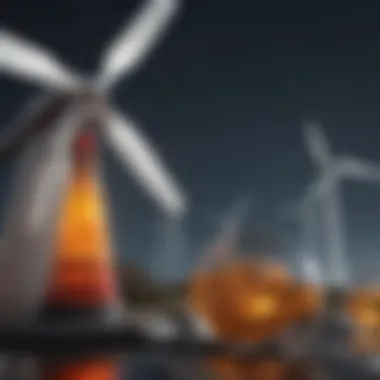
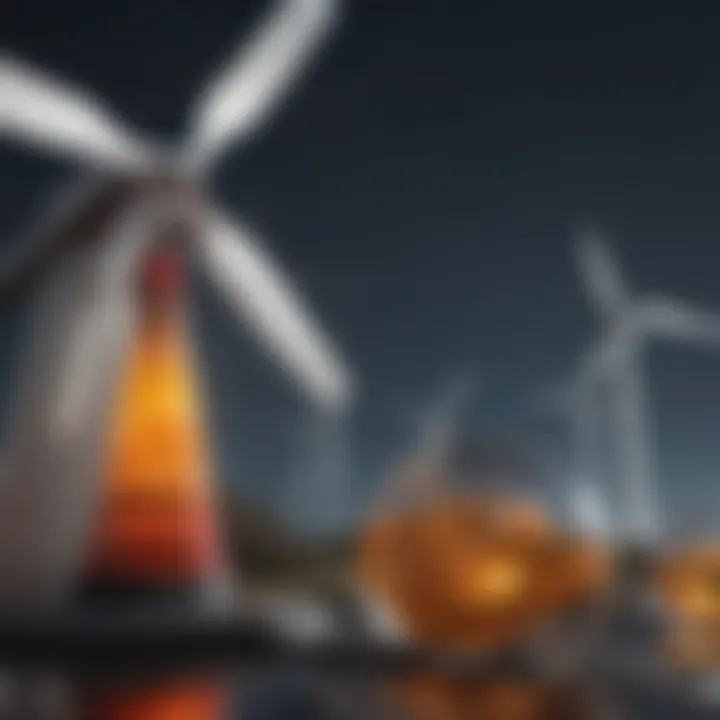
External Costs: Fossil fuel generation creates substantial externalities, such as health costs associated with air pollution and the economic impact associated with climate change. When you consider these costs, as well as the incentives and subsidies for renewables, the cost-effectiveness of wind power strengthens considerably.
Market Trends: As the technology improves and economies of scale are realized, the gap between wind and fossil fuel costs continues to narrow. Recent studies suggest that levelized cost of energy for onshore wind is often lower than fossil fuels, particularly in regions where wind resources are abundant.
Hydropower: A Comparative Study
Switching gears to hydropower, we encounter another renewable energy form equally celebrated but constrained by geographical limitations.
Installation Costs and Viability: Hydropower projects typically demand substantial initial investments and extensive infrastructure. Large dams can carry hefty environmental impacts, which wind installations don’t inherently incur. The cost of maintaining hydropower facilities can also escalate due to sediment management and ecological concerns.
Social Impact: Another layer to consider is the social fabric around energy generation. Wind projects are generally easier to implement in a community-friendly manner compared to hydropower projects, which can displace communities and disrupt ecosystems due to damming rivers.
Energy Production Consistency: When it comes to energy output, hydropower is notable for its ability to produce consistent power when water flow is stable. However, droughts and shifting climate patterns can affect availability. In contrast, while wind energy can be intermittent, it’s not tethered to seasonal patterns, making it a more versatile option in multi-faceted energy strategies.
In summation, comparing wind power with other energy sources reveals a tapestry of considerations—financial aspects, societal impacts, and environmental factors. Recognizing the strengths and weaknesses of each will pave the way towards a more sustainable energy future.
Financial Impacts of Wind Power Adoption
Understanding the financial impacts of wind power adoption is crucial for stakeholders—be it government bodies, investors, or energy consumers. The topic encompasses not just the costs of implementation but also the long-term economic advantages that can emerge from integrating wind energy into our energy systems. The movement towards renewable energy is not just a nod to sustainability; it's increasingly becoming a sound financial decision as well.
Long-term Savings and Benefits
In terms of savings, wind power often shines, particularly over extended periods. When looking at initial capital investments, solar and fossil fuel energy sources might seem appealing at first glance due to lower upfront costs. However, a deeper dive reveals that wind energy typically incurs lower operational costs over time.
- Reduced Fuel Costs: Unlike fossil fuels, wind power relies on a free, inexhaustible resource—the wind. This means that once turbines are installed, the ongoing cost is largely tied to maintenance rather than purchasing fuel.
- Stable Pricing: With wind energy, consumers can often expect more stable pricing. The volatility of fossil fuel markets can lead to fluctuating energy prices, whereas wind energy offers more predictable long-term costs.
- Job Creation: The shift towards wind power is also tied to job creation in manufacturing, installation, and maintenance. These jobs often support local economies, further enhancing the financial benefits of adopting wind energy.
These cumulative savings not only contribute to lowering energy bills but can also lead to economic growth within communities that invest in wind power infrastructure.
Government Incentives and Subsidies
Government incentives play a significant role in making wind power adoption more financially viable. Various forms of subsidies and tax incentives may encourage investment and deployment, bolstering the overall economic landscape.
- Tax Credits: Many regions offer tax credits for wind energy projects. In the United States, the Production Tax Credit (PTC) provides financial incentives based on the amount of electricity produced from wind. This substantially lowers the effective price of energy in the long run.
- Grants and Funding: Federal and state governments often provide grants aimed at reducing the initial capital burden that comes with wind project development. These can cover everything from research and development to actual construction costs.
- Renewable Portfolio Standards (RPS): Many jurisdictions have set requirements that a specific percentage of energy must come from renewable sources. This legal commitment often creates a favorable market environment for wind energy investments, attracting further funding.
Such incentives not only bring down costs but also promote faster adoption rates, making wind energy an attractive option for many stakeholders.
Investment Trends in Renewable Energy
The investment landscape for renewable energy, particularly wind power, is evolving rapidly. A tantalizing mix of sustainability, technological advancements, and economic rationale has piqued the interest of both institutional and private investors alike.
- Growing Market Size: The global wind power market is on a growth trajectory, with investments skyrocketing. In 2020, despite the pandemic, investments in renewable energy still reached significant heights, emphasizing resilience against economic downturns.
- Emerging Funds: Numerous funds dedicated to renewable energy projects are springing up, supported by both government mandates and market demand for sustainable investment options. This trend suggests a shifting mindset where investors increasingly consider long-term sustainability over short-term gains.
- Diversified Portfolios: Many financial institutions are integrating renewable energy assets into their portfolios, viewing wind power as a reliable source to balance traditional, more volatile energy investments.
These trends indicate a significant shift toward recognizing wind energy, making it not just a necessary step in combating climate change but also an increasingly smart economic decision for the future.
Environmental Considerations
Understanding the environmental considerations surrounding wind power is critical for grasping its overall impact as a sustainable energy solution. Wind energy is often lauded for its low carbon emissions and reduced reliance on fossil fuels. However, the implementation of wind farms can bring about various ecological consequences that deserve careful scrutiny. This section delves into the nuances of wind power's environmental footprint, touching upon its carbon emissions, impacts on wildlife, and land use concerns, ultimately shaping a comprehensive view of this renewable resource.
Carbon Footprint of Wind Energy
When discussing the carbon footprint associated with wind energy, it’s essential to consider the entire lifecycle of wind power generation. Unlike fossil fuels, wind energy produces no direct greenhouse gas emissions during operation. This stark contrast plays a significant role in the effort to mitigate climate change.
However, the initial stages of wind turbine development and installation do carry some environmental cost. Manufacturing turbines involves energy consumption, typically supplied by non-renewable sources, which can generate emissions. Furthermore, transporting these large structures to their installation sites also contributes to the carbon footprint.
To illustrate, a life-cycle assessment conducted by researchers found that the carbon emissions associated with wind power are significantly lower than those of coal or natural gas. In fact, over a 20-year operational life, the average wind turbine offsets its initial carbon footprint approximately 12 times over.
Impact on Wildlife
The relationship between wind power and wildlife is a complex tapestry. On one hand, wind farms can disrupt local ecosystems and pose threats to bird and bat populations. Studies have shown that some bird species are susceptible to collisions with turbine blades. For example, certain migratory birds may not navigate effectively around these structures, leading to increased mortality rates.
On the flip side, many wind energy developments now prioritize environmental considerations during site selection and turbine design to minimize these impacts. Implementing technology such as radar systems to detect approaching wildlife can significantly reduce risks. Additionally, establishing wind farms in less critical habitats can help balance energy needs and ecosystem preservation.
"While the potential threats to wildlife from wind turbines raise valid concerns, ongoing advancements in technology offer solutions to mitigate these risks."
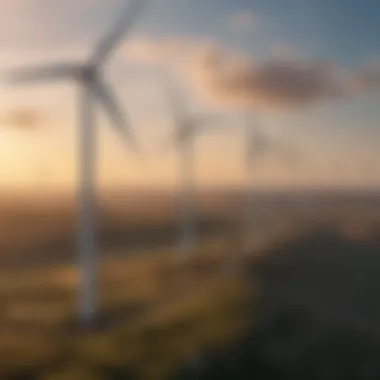
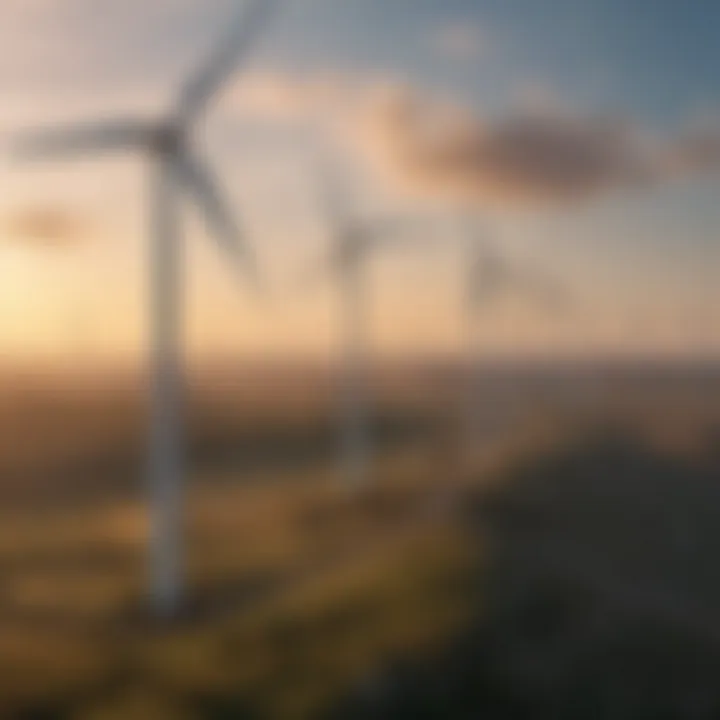
Land Use and Community Effects
The land requirements for wind farms can be a contentious topic in discussions about their environmental implications. The footprint of a single wind turbine may seem modest, but large-scale installations can occupy significant tracts of land. This land use often raises concerns about competing interests, including agriculture, wildlife habitats, and human development.
In many cases, the land used for wind farms is compatible with agricultural practices, allowing for dual land use. Farmers can still grow crops or graze livestock around the turbines, which minimizes the overall disruption to local economies. This synergy presents a unique opportunity for sustainable development and land management.
Nevertheless, community effects must also be weighed. Local residents may express concerns about noise, aesthetics, and perceived impacts on property value. Engaging communities in the decision-making process and addressing their concerns can be vital in ensuring acceptance and support for wind projects.
When planning future wind energy developments, it’s crucial to conduct thorough assessments regarding land use and to actively involve local stakeholders to foster positive relationships and outcomes.
Barriers to Wind Power Implementation
Wind power stands as a symbol of hope in the clash against climate change, making its potential hard to ignore. However, the journey toward widespread adoption is not without its bumps. The barriers to implementing wind power must be understood thoroughly, as they encompass regulatory hurdles, societal perceptions, and technological constraints—each playing a significant role in shaping the future of wind energy.
Regulatory Hurdles
One of the chief barriers encountering wind power development are the regulatory hurdles. Each region has its own set of laws governing the energy landscape, and navigating these can be as tricky as threading a needle. Permitting processes can vary greatly from one location to another, and often include lengthy approval timelines. Moreover, regulations may change, leaving developers in a lurch, wondering whether their investments will yield returns.
- Zoning Restrictions: In many areas, local zoning laws can limit where wind farms can be located. Zones meant for agricultural or residential purposes may not allow for the construction of wind turbines, even if the location is technically suitable for wind energy generation.
- Interconnection Standards: Getting power from a wind farm to the grid can also pose challenges. Each utility or grid operator has its own interconnection standards, potentially requiring extensive upgrades to existing infrastructure.
Such complications can translate to significant delays and increased costs, which could render a project unappealing to investors. Policies promoting simplicity and consistency in regulations could drastically change the landscape for deploying wind energy.
Public Perception and Acceptance
Public cognition is another obstacle facing wind power implementation. While many recognize the benefits of wind energy, some voices remain skeptical. This skepticism can arise from various concerns, often influenced by local culture or historical contexts.
Concern around aesthetic values of the landscapes often comes into play. Turbines are gigantic and, to some, might seem intrusive in natural settings. Local communities sometimes argue over the implications on property values and scenic views, claiming a wind farm could diminish the charm of their surroundings.
Building trust and engaging with communities in the early stages of the development process can help dismantle these obstacles. Conducting outreach efforts through town hall meetings, offering educational workshops, or even collaborating with local stakeholders can change the narrative and promote acceptance.
Technological Limitations
Lastly, despite the advances made in wind technology, there are still technological limitations that pose challenges. Each turbine has its operational limitations, like the need for a certain wind speed to function efficiently. If conditions are not right, the energy generation may not meet expectations, which in turn affects the overall economics of wind power.
- Efficiency of Turbines: Older turbine models are less efficient compared to their newer counterparts, meaning they generate less energy for the same wind conditions. Updating fleets presents a massive capital investment, which may discourage some developers.
- Grid Compatibility: Integrating wind energy with existing power grids can also be an uphill battle. Since wind power is intermittent, it can lead to fluctuations in energy supplied to the grid. Modern solutions like energy storage or hybrid systems need further development to enhance reliability.
All these barriers demand attention and ingenuity. Addressing regulatory hurdles, winning public support, and overcoming technological limitations will require concerted efforts from policymakers, companies, and communities alike to unlock the full potential of wind energy. Through strategic actions, the wind power industry can hope to bridge the gap from skepticism toward adoption, ensuring that the promise of cleaner energy doesn't go begging.
Future of Wind Power
Importance of the Topic
The future of wind power is not merely a passing trend but a crucial pillar in the shift towards sustainable energy. With growing concerns over climate change, the conversation around renewable energy sources often hones in on their viability and benefits. Wind power stands out due to its capacity to provide clean energy while also presenting economic advantages over time. Observing global trends, it becomes evident that governments, corporations, and communities are increasingly adopting wind energy as part of their long-term strategies.
Emerging Markets and Opportunities
In this ever-evolving landscape, emerging markets are ripe with opportunities for wind energy development. Countries that once relied heavily on fossil fuels are now investing in wind power, motivated by the dual goals of energy independence and environmental sustainability. Nations such as India and Brazil are exhibiting robust growth in wind energy installations, driven by governmental support and an increasing need for reliable electricity sources.
Some key points include:
- Government incentives: Nations are implementing tax breaks and subsidies to support wind energy projects.
- Investment growth: Private investors are more willing to fund wind energy projects due to the potential for long-term returns.
- Skill development: New jobs in construction, maintenance, and management are being created in the renewable sector.
"The wind energy sector is rapidly growing, and with that comes a myriad of opportunities that can not only benefit economies but also support global efforts towards a sustainable future."
Integration with Other Renewable Sources
With increased focus on hybrid systems, the future of wind power lies in its integration with other renewable energy sources. Solar photovoltaic systems, for instance, can complement wind energy by providing consistent power during peak sunshine hours, effectively balancing the overall energy output throughout the day.
Consider these aspects of integration:
- Grid Reliability: Enhanced reliability can be achieved by combining wind power with other sources like biomass or hydroelectricity.
- Storage Solutions: Technologies such as batteries can store excess energy generated by both solar and wind, providing a more stable supply during low production periods.
- Collaborative Infrastructure: Shared infrastructure for multiple energy sources can reduce operational costs and streamline maintenance efforts.
Innovative Research Directions
Innovation is paramount in driving the future of wind power. Research institutions and private companies are tirelessly exploring new ways to make wind energy more efficient, affordable, and accessible. Key areas of focus include:
- Advanced turbine technologies: Research into larger blades and more efficient mechanisms is ongoing, which will enhance energy capture.
- Floating wind farms: Emerging technologies allow wind turbines to be placed in deeper waters, exploiting stronger winds and reducing land use conflicts.
- Data analytics and AI: Integrating advanced data analytics helps optimize wind farm operations and maintenance schedules to maximize output and reduce costs.
As the landscape of wind energy continues to unfold, stakeholders must remain alert to the vast potential that lies ahead. The synergy of emerging markets, integration with other renewables, and ongoing research could very well redefine our energy future.



